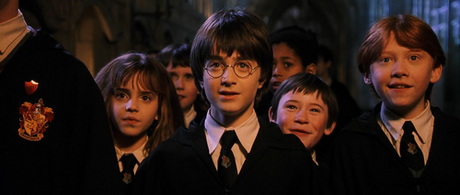
Emma Watson, Daniel Radcliffe, Rupert Grint in Harry Potter and the Sorcerer’s Stone
With a wave of a magic wand, a favorite children’s novel came to life on the big screen, its English literary sources intact
Think of it! Where would the English-speaking world be without the likes of Charles Dickens, Emily and Charlotte Brontë, Jane Austen, J.R.R. Tolkien, C.S. Lewis, and other gifted writers to inspire and enthrall us afresh and anew? For that matter, where would American, if not British cinema, be without exploiting the literary merits of the above-named authors to their fullest?
Such is the case with Warner Bros. Studio’s Harry Potter and the Sorcerer’s Stone, their extremely faithful (too faithful, perhaps) 2001 film rendering of J.K Rowling’s wonderful children’s novel about the orphaned wizard-to-be, eleven-year-old Harry Potter, and the discovery of his new-found magical abilities.
Known in the U.K. as Harry Potter and the Philosopher’s Stone, Rowling’s original title was altered and released in the U.S. and other countries under the Sorcerer’s Stone banner (a quite common occurrence, it would seem – see Philip Pullman’s The Golden Compass as a prime example). Regardless of which title it’s known by, the Harry Potter series of books were, and remain to this day, one of those unforgettable creations that continue to draw readers, both young and old, by the millions to its supernatural story lines. The subsequent box-office appeal of the movies have fed the constant thirst for more of this remarkable character’s adventures.
Now, about those story lines: they may not be as “original” as they were initially thought to be. If one can read between the lines, so to speak, and “see” beyond the fanciful trimmings and Latin-based terminology, overlooking the author’s imaginative blending of preexisting plot elements with a modern, existential-like worldview, the reader (and, likewise, the moviegoer) can readily pick up on Ms. Rowling’s literary sources and influences.
Let’s start with the basic plot. When Harry Potter, who’s been orphaned after his parents were mysteriously killed in a car crash (or so he’s been told), learns of his amazing powers, he leaves the harsh environment of his aunt, uncle, and bullyboy cousin, a.k.a. the Dursleys (short for “desultory,” one gathers), to be sent off to hone his skills at Hogwarts School of Witchcraft and Wizardry. Rather like Charlotte Brontë’s Jane Eyre, isn’t it? Or more accurately, Dickens’ Oliver Twist, a story with more twists and turns than those mythical, magical labyrinths Rowling is so fond of citing in her later Harry Potter and the Goblet of Fire (2005), one of the film series’ more elaborately worked out sequels.
What about David Copperfield, Dickens’ most ambitious, autobiographical depiction of Industrial-Age Britain at its worst? Isn’t Mr. Micawber, so flamboyantly portrayed by W.C. Fields in MGM’s film classic, a rumpled, soused-up personification of Hogwarts’ groundskeeper Rubeus Hagrid, a character whose main purpose (outside of helping dragons hatch out of their shells) is to act as an ersatz deus ex machina, coming to Harry and his friends’ rescue (and vice versa) when it suits the situation?
And what does one make of Professor Albus Dumbledore, the dean of Hogwarts, a wizened old soul straight out of Tolkien’s Lord of the Rings? His bedside manner and resigned recapitulation of events, as Harry lies in the school’s hospital ward recovering from his near-fatal experience with He Who Must Not Be Named, kindle memories of a similar encounter with the White Wizard Gandalf and a wounded Frodo Baggins from Peter Jackson’s The Fellowship of the Ring, which premiered in 2001 – at about the same time as Harry Potter and the Sorcerer’s Stone was released.
The same sensibility that governed such classics as David Copperfield, Oliver Twist, A Christmas Carol, Jane Eyre, and, in particular, Thomas Hughes’ Tom Brown’s School Days (doesn’t Slytherin House’s blonde-haired Draco Malfoy – that sniveling, bigoted, and conniving upper-class rich kid – remind you of the intractable Flashman?)is at work here, which only deepens one’s admiration of, and appreciation for, Jo Rowling’s genius for invention.
Rule Britannia!

The fabulous Quidditch match
With all of the above being said, there are many memorable moments in this spectacular movie production, including the congregation of owls sequence at the Dursley’s (with its hundreds of Hogwarts letters flittering about), the giant Hagrid’s door-busting entrance, the fog-enshrouded boat ride to Hogwarts School, the fabulously executed Quidditch match (watch out for those bludgers, fellas!), the troll attack in the girl’s lavatory, the life-size chess match (with Harry’s best friend Ron Weasley leading the charge), and the frightening encounter with the Dark Lord Voldemort in the Forbidden Forest.
For the adults, there’s outstanding acting by a veritable Who’s Who of Her Majesty’s supporting players – insisted on by Rowling herself – including soft-spoken Richard Harris as Professor Dumbledore, sad-eyed Maggie Smith as Minerva McGonagall, Robbie Coltrane as Rubeus Hagrid, Alan Rickman as Professor Snape, the snooty Defense against the Dark Arts teacher, along with Richard Griffiths, Fiona Shaw, Julie Walters, Ian Hart, Warwick Davies, and former Monty Python regular John Cleese as the ghostly “Nearly Headless” Nick. There’s even a cameo by that old scene-stealer, John Hurt, as Mr. Olivander, purveyor of fine wands since 362 B.C.
For the kiddies, there are star-making turns by the young Daniel Radcliffe as Harry, Rupert Grint as his redheaded buddy Ron, and especially Emma Watson as the bookish Hermione Granger, as well as Matthew Lewis as never-say-die student Neville Longbottom. A superbly flavorful score by veteran John Williams, destined to become a classic, is pure icing on this frothy concoction. The marvelously condensed screenplay by Steve Kloves pares down and captures the novel’s essence – a truly remarkable job; while the whole production is directed in grand style by Chris Columbus.
Some scenes are a bit too intense for younger viewers, especially the entrance of the evil wizard Voldemort. Otherwise, this is fine family entertainment all-around and very highly recommended.
Copyright © 2013 by Josmar F. Lopes

